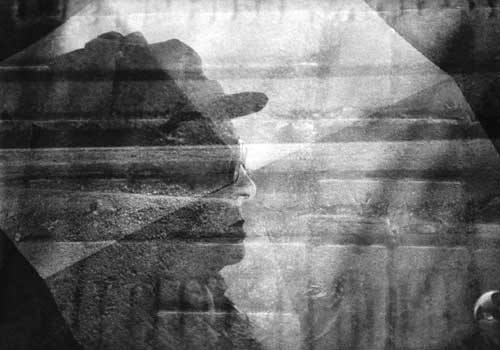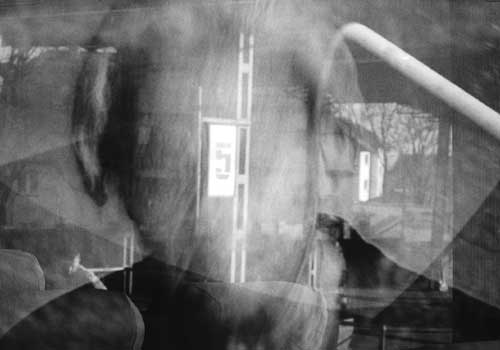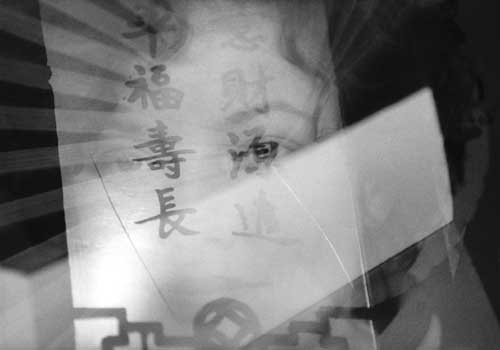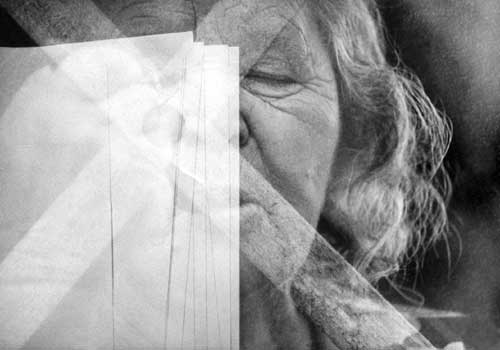



Memory is the subject of all three series of photographs by Andrzej P. Bator; their style is different but they remain within the sphere of the problem of memory. The first of the aforementioned series, consisting of contact photographs (its other version consists of large-format prints) and entitled "Places of Oblivion" ("Miejsca bezpamięci", 1998-2001) juxtaposes the aesthetics of the so-called "pure photography" and a conceptual approach: in each case a symbolic, empty sheet of paper is inscribed into the given frame, containing a fragment of a landscape or an interior. This alien element, a sign of the photographer's consciousness which disturbs the view, destroys the realism of the image and transfers the burden of meaning from external reality into the psychological and intellectual interior. These perfectly composed images that can catch light in its whole spectrum of subtle tonal changes and therefore fulfill all the conditions that a good "subjective document" should, are actually directed against this kind of aesthetics. They reveal that what determines the meaning of a documentary view - its reference to the contents of the memory of the author of those photographs - cannot be communicated even by means of the most realistic image and remains illegible to the viewer. And an empty sheet of paper, a symbol of consciousness open to registration in memory, becomes a leading motif of the next photographic series.
"Places of Oblivion", as well as "Still Lives of Memory" ("Martwe natury pamięci") and later "Anamnesis - [Re]construction of an Image" ("Anamnesis - [re]konstrukcja obrazu"), by way of their concept and aesthetics enter the discourse on the links between photography and memory, not to mention the discussions on the ontological status of a photographic image. This philosophical depth of the photographs by Andrzej P. Bator naturally results from his professional interests, since he is scholar in the field of philosophy. However, two recent sets of his photographs and especially the third, the latest one, gradually present themselves as autonomous works of art, full of internal, metaphorical meanings which exist independently from the path of their discoursive philosophical interpretation.
"Still Lives of Memory" (1999-2000) approach the title topic not from the objective point of view, where photography is associated with memory as a document - a relic of the past, a trace, a record of a concrete place and time - but in its subjective aspect. The images from this series imitate the structure of memorial registration, showing fictional spaces, created by means of fitting together into one frame a few consecutive expositions of certain simple objects, like a heap of clean sheets of paper, sticks of glass or a glass ball. These overlapping layers of images that permeate one another create a kind of reality which has never existed in such a form in the real world - it has been created in the imagination of the author and belongs wholly to the sphere of his individual consciousness. This method of creating an image repeats the process of shaping one's personal memory: all images-memories that are accumulated during the course of our lives combine, building a unique, specific and elusive - as it cannot be fully expressed - space of the spiritual identity of every human being.
In "Still Lives of Memory" this internal - psychological and intellectual - sphere is just as unattainable for the observer as when it was symbolized by an empty sheet of paper placed among of the landscapes of the "Places of Oblivion". However, there is a certain meaningful difference here: symbolism of objects used to set the scene, both taking each of them separately as well as put together, and the emotional, metaphorical expression of the created spaces based on some kind of action cause photographic images to open up for the individual interpretation of the viewer. Individual works of this series are metaphorical images of values important in the life of the author or of events that have been significant for him. Therefore, the titles of the works carry a private, personal meaning, like "Family" ("Rodzina"), "Martial Law" (Stan wojenny") and "The Absolute" ("Absolut"). However, it is not important for the viewer to decipher those personal meanings - because for Andrzej P. Bator artistic expression is not an intimate confession that reveals vulnerable points of the artist's personality. A work of art directed to the viewer - to another person - is a dialogue, a form of confession which uncovers an important part of one's ego, but which has to do with universal problems that are important for every human being. Images arranged in a linear sequence of various emotional situations registered in memory build "the melody of life", a specific abstract diary on whose pages the viewer may inscribe himself, identifying individual phrases of this melody with his own life experiences for his personal use.
In this second series of staged photographs a photograph conceived as material for conscious artistic creation was set against the photographic document from the previous series. "Still Lives of Memory" are a development of the second point of discussion of which the first - the starting point - were "Places of Oblivion". The documentary, realistic image of reality - i.e. an image whose meaning is based on the registration of a concrete place at a concrete moment in time - is an image that is dead for the external observer who is not connected with this place and time by means of his own memories: such is the sense of the message of the photographs by Andrzej P. Bator. A photographic document has value only for its author because its complementation may be found in his memory. When it is dragged out of its context and deprived of authorial commentary it does not mean almost anything. However, no great events or unique places are necessary here - as the photographs of the next set seem to prove - and sometimes an image of a few trivial objects is enough to create a new, fictional reality; a reality full of meanings which stimulate the viewer's emotions and evoke his own memories and imagination.
The idea of photography contained in the works of Andrzej P. Bator is an idea which is, on the one hand, categorical, and on the other not very popular among photographers. Since the invention of the photographic medium its specific and unique value was usually attributed to the documentary fidelity of the photograph and the veristic character of photographic registration. It was precisely for this reason that Roland Barthes could define photography as "an image without a code", which means that objects are literally registered and copied in front of the camera - and that their copies replace reality itself without constructing any meanings. Andrzej P. Bator, speaking from a phenomenological point of view, claims that the photographic image in itself is not an image of an object - and that it only registers visual phenomena as a set of bright and dark spots in the emulsion of a negative or photographic paper. "The image of an object" is rather created later by our memory - it is contained not in the objective, physical or chemical aspect of photography but in the subjective aspect of its reception. The image is an image only in the consciousness of the viewer and it does not exist without it.
In the illusory spaces of "Still Lives of Memory" the viewer's eye does not distinguish between the separate layers of this multi-exposition - they are braided with one another so closely that the space of the image creates the illusion of a real landscape. In "Anamnesis - [Re]construction of an Image" (2001-2004) the situation is different. The images immediately betray their character as well as the fact that we have to do with many overlapping expositions although we are unable to find the edges of individual frames. Looking at these portrait photographs the viewer suddenly discovers that his vision has been pulled deep into the image by one of the illusory spaces of which it is made up, removing all others from the field of our vision. But after a while another layer of the image is activated, creating a new illusion of reality. Looking at the photograph becomes a visual journey to new "worlds" hidden in one multi-layered frame. The structure of "the plate of memory", reconstructed in each of them, does not create a homogenous and static world, like in "Still Lives of Memory". When we submerge in the image we start to move not only in space, but also in time, finding first individual images of which it is made up, and then putting them together again in our imagination. This journey shows that memory is a movable and living structure that changes with each moment; it shows us memory in action, at the moment when memories are activated.
Moving from image to image in the sequence of portraits from "Anamnesis." we follow the author step by step through the process of their creation. Revealing the structure of the image does not dismiss the magic of fictional reality into which we are pulled. On the contrary, the possibility of active participation of imagination in the reconstruction of the image (the reconstruction of the author's actions) and the journey to its consecutive layers becomes a fascinating adventure of our consciousness, a discovery of its previously unknown spheres.
Each of the individual images hidden in portrait photography tells metaphorical tales about the model whose face is the dominating element of the frame, adding something new and different to its spiritual image. Symbolic images of birds, water, trees, walls, doors or windows open the space of a psychological interior which even the most sophisticated lens cannot penetrate. Those portraits, however, have been created in the author's imagination - and we are reminded of it once again by the symbolic sheet of white paper which appears in each image. Therefore, those photographs are double portraits because they tell us something not only about the person depicted but also about the photographer himself. Constructing the image also means constructing the image of that someone of whom the author is thinking in our consciousness. In the "Anamnesis." series photography is neither the point of destination nor the aim. The process of photography, analogous to the way in which memory and imagination functions, becomes the method of living one's life, of building one's own "archives of memory" in which the portraits of the people one has met occupy an important place - both the portraits of close acquaintances and friends, and the portraits of those people one sees only from a distance or meets once in a lifetime.
Our memory contains many images remembered from various moments in life but their meaning for our whole psychological and intellectual identity is created only in relation to other memories and to what we are experiencing at the present moment. Images of memory and their analogues - photographic, documentary registrations - are but raw material, the starting point for the creation of a subjective, individual world of values which also, but this time only metaphorically, may also be considered to be "an image". However, it is a mental image, consisting of sensual impressions, emotions and reflections. Its reconstruction in the form of a visual image may take the form of a photograph and be realized by mean of photography, but only as a metaphor - never literally.
Such is the third point in the discourse on photography and memory which Andrzej P. Bator makes in his latest photographic series "Anamnesis - [Re]construction of an Image".
Although photography as such - photography as reflection of reality, as its realistic image - is never the ultimate aim of those works, it is one of their specific subjects. In order for memory and consciousness to exist, they must be preceded by reality to which internal, psychological and intellectual life relates. Memory must be the memory of something, just like consciousness - the consciousness of something. Therefore, the anchoring of a pure photographic frame in reality (as we cannot photograph anything, whatever it might be, that has not appeared in front of the camera) becomes an absolute and unquestionable ontological foundation of the works by Andrzej P. Bator and gives meaning to everything that they give evidence to through their fictional, metaphorical images - because it is a foundation based on reality, not on pure fiction.
Elżbieta Łubowicz, April 2005





Exhibition organized as part of an
OPERATIONAL PROGRAMME
"Art Promotion"
of the Ministry of Culture of the Republic of Poland
Copyright ©2005 Galeria FF ŁDK, Andrzej P. Bator, Elżbieta Łubowicz.